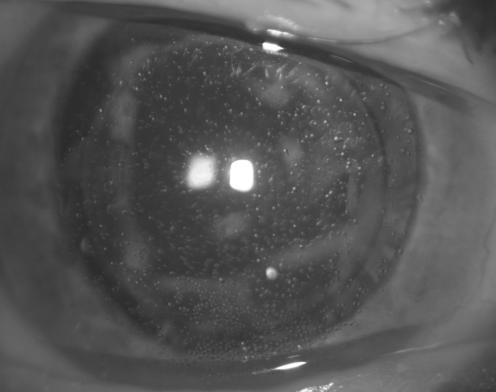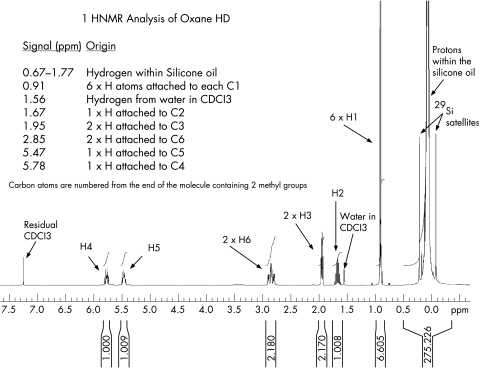Abstract
Background
Oxane HD is a mixture of 5700 cs silicone oil and RMN‐3 (a partly fluorinated olefin), which has a specific gravity greater than water, thereby enabling endotamponade of inferior retinal breaks. Droplets of emulsified oil were found in the anterior chamber of two patients with complex retinal detachments who had been treated with Oxane HD. Samples removed from these two eyes were analysed in order to investigate the nature of the emulsified substance.
Methods
Samples were dissolved in CDCl3 and, if necessary, dried using magnesium sulphate. Nuclear magnetic resonance (NMR) was used to compare these samples with the unused commercial product.
Results
NMR analysis of the samples removed from the anterior segment of both eyes were mainly silicone oil with only trace amounts of RMN‐3. Samples taken from different areas of an unused syringe of Oxane HD demonstrated varying concentrations of the RMN‐3 compound within the silicone oil.
Conclusion
First, the mixture of RMN‐3 and silicone oil is not homogenous either in vitro or in vivo. Second, emulsified oil found in the anterior chamber is composed almost entirely of silicone oil, containing only trace amounts of RMN‐3.
Keywords: silicone oils, emulsification, retinal detachment, magnetic resonance spectroscopy
Oxane HD (Bausch and Lomb, Toulouse, France) is a “heavy silicone oil” that has been investigated in two trials.1,2 The mixture of 5700 cs silicone oil and RMN‐3, a partly fluorinated olefin, has a specific gravity closer to water than Densiron (perfluorohexyloctane/silicone oil). This has been shown to reduce the effectiveness of the endotamponade.3
Emulsification of Densiron and Oxane HD has been reported.2,4 We investigated samples removed from two eyes with dispersed Oxane HD.
Case 1
A 50‐year‐old pseudophakic man underwent vitrectomy using Oxane HD for a recurrent inferior retinal detachment, which four vitrectomies, including an encircling band, had failed to treat. The subretinal fluid (SRF) was not drained, because the detachment was shallow, there was no obvious break through which to drain and an inferior retinotomy was undesirable. Two factors may have promoted an underfill. First, the presence of encircling bands,3 and second not draining the SRF causes an underfill once the SRF has absorbed. An underfill may promote emulsification, as the oil bubble would be more mobile within the posterior segment. Seven weeks postoperatively, emulsified droplets were found in the anterior chamber (fig 1). Some droplets were concentrated inferiorly, whereas others were suspended.
Figure 1 Appearance of dispersed Oxane HD at 7 weeks post‐heavy oil injection.
Case 2
A 38‐year‐old phakic man underwent a third vitrectomy for an inferior recurrence. SRF was drained under air through a retinotomy and Oxane HD was then injected. Thirty‐seven days post‐operatively, oil droplets were found in the anterior chamber.
In both cases, neither heavy liquid nor silicone oil had previously been used and an infusion of balanced saline solution was running when the posterior segment oil was removed.
Materials and methods
Nuclear magnetic resonance (NMR) has been used before5 to analyse silicone oil removed from human eyes and allows simultaneous analysis of the volatile RMN‐3 and the non‐volatile silicone oil.
In order to remove the water from the anterior chamber samples, they were dissolved in deuterated chloroform (CDCl3), which contains predominantly deuterium and does not produce a significant signal in proton (1H) NMR. The samples were shaken and left overnight. Two layers resulted; the top hydrophilic layer was discarded, and the bottom layer containing the CDCl3 and hydrophobic elements was analysed The samples from case 2 contained excess water and were dried using magnesium sulphate, a standard drying agent. The magnesium is not a highly coordinating ion in this compound and would not have any complexing capability with the fluoro‐olefin compound. As a result of the small size of the anterior chamber, it was not possible to take more than one sample from each eye.
The samples from the posterior segments naturally split into a hydrophilic aqueous phase and a hydrophobic oleaginous phase. The oil was easily separated from the infusion fluid and pipetted directly into CDCl3. The ionic solutes within the infusion fluid would not enter the hydrophobic phase.
The 1H NMR samples were run in standard 5 mm diameter borosilicate glass NMR tubes using a Bruker DRX500 (Bruker Biospin Corp., Billerica, Massachusetts, USA) operating at 500.13 MHz with a 5 mm total body irradiation probe. The 19F and 13C samples were performed on a Bruker AV300 (Bruker Biospin Corp.) operating at 282.23 MHz for 19F and 100 MHz for 13C with a direct detection 5 mm QNP probe.
Results
1H NMR and 13C NMR multidimensional data showed the structure of RMN‐3 to be C7F15CF2CH2CH = CHCH2CH(CH3)2. Figure 2 shows the 1H NMR analysis of unused Oxane HD.
Figure 2 Proton NMR analysis of unused Oxane HD.
19F NMR analysis revealed only a trace amount of a fluorine‐containing compound in the anterior chamber of both eyes. 1H NMR of the anterior segment samples showed barely detectable signals from RMN‐3 in case 1 and no signals from RMN‐3 in case 2.
Signals in the olefinic range were found that did not correspond to signals found in the reference sample of Oxane HD. These signals were barely detectable in both samples and probably represent fatty acids or other small to medium length hydrocarbons in the aqueous. 13C NMR may have explained these signals, but was not possible on such small samples.
Repeat analysis of samples removed from the posterior segment produced conflicting results. One sample contained small amounts of RMN‐3, whereas a second sample from the same posterior segment of the same eye contained almost normal levels of RMN‐3.
This discrepancy led us to re‐analyse the manufacturer's syringe, which was shaken and left standing vertically at room temperature. To compare the amount of RMN‐3, we normalised the RMN‐3 signal at 2.85 ppm to the residual deutero‐chloroform hydrogen signal at 7.25 ppm. Results at 1, 5 and 6 months showed that the height of the 2.85 ppm signal compared with the height of the 7.25 ppm signal was 17%, 12% and 15%, demonstrating that the mixture of RMN‐3 and silicone oil is not homogenous in vitro and at room temperature.
Discussion
Our analysis showed only a trace amount of RMN‐3 in the anterior chamber; however, clinically the oil droplets in the anterior chamber were found to be settling as well as floating. It would have been difficult to separate these two populations of droplets and analysis of such minute quantities may well have been meaningless. Our analysis reflects the overall composition of the oil droplets in the anterior chamber. Intuition suggests sunken droplets contained more RMN‐3 and there were simply too few of these sunken droplets in the eye (or our sample) for a significant quantity of RMN‐3 to be detected overall.
In samples removed from a syringe containing unused Oxane HD, we found local variations of the concentration of RMN‐3 within the solution, demonstrating a heterogeneity in the concentration of RMN‐3 within Oxane HD in vitro. Presumably this heterogeneity occurs in vivo, because the anterior chamber samples contained only trace amounts of RMN‐3. We hypothesise that it is those areas of the oil bubble with a low concentration of RMN‐3 that are able to emulsify and enter the anterior chamber.
This preliminary study shows the mixture of silicone oil and RMN‐3 is not homogenous in vitro and suggests that the mixture may not be homogenous in vivo. The small number and volume of samples limit our investigations and we would recommend further studies.
Abbreviations
CDCl3 - Deuterated chloroform
NMR - nuclear magnetic resonance
SRF - subretinal fluid
Footnotes
Competing interests: None.
Presented to the British and Eire Vitreoretinal Society Meeting, Cheltenham on 3 November 2005.
Informed consent was obtained for publication of the persons' details in this report.
References
- 1.Wolf S, Schon V, Meier P.et al Silicone oil‐RMN3 mixture (“heavy silicone oil”) as internal tamponade for complicated retinal detachment. Retina 200323335–342. [DOI] [PubMed] [Google Scholar]
- 2.Rizzo S, Genovesi‐Ebert F, Belting C.et al A pilot study on the use of silicone oil‐RMN3 as heavier‐than‐water endotamponade agent. Graefes Arch Clin Exp Ophthalmol 20052431153–1157. [DOI] [PubMed] [Google Scholar]
- 3.Wetterqvist C, Wong D, Williams R.et al Tamponade efficiency of perfluorohexyloctane and silicone oil solutions in a model eye chamber. Br J Ophthalmol 200488692–696. [DOI] [PMC free article] [PubMed] [Google Scholar]
- 4.Wong D, Van Meurs J C, Stappler T.et al A pilot study on the use of a perfluorohexyloctane/silicone oil solution as a heavier than water internal tamponade agent. Br J Ophthalmol 200589662–665. [DOI] [PMC free article] [PubMed] [Google Scholar]
- 5.Gungel H, Menceoglu Y, Yildiz B.et al Fourier transform infrared and 1 h nuclear magnetic resonance spectroscopic findings of silicone oil removed from eyes and the relationship of emulsification with retinotomy and glaucoma. Retina 200525332–338. [DOI] [PubMed] [Google Scholar]




